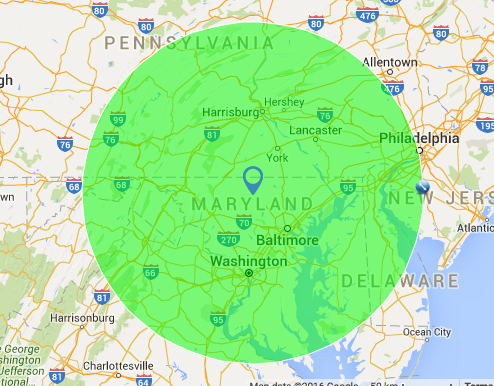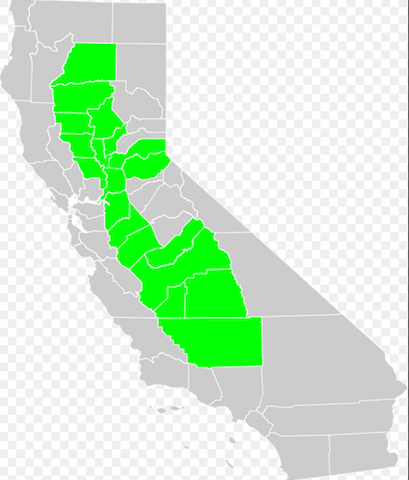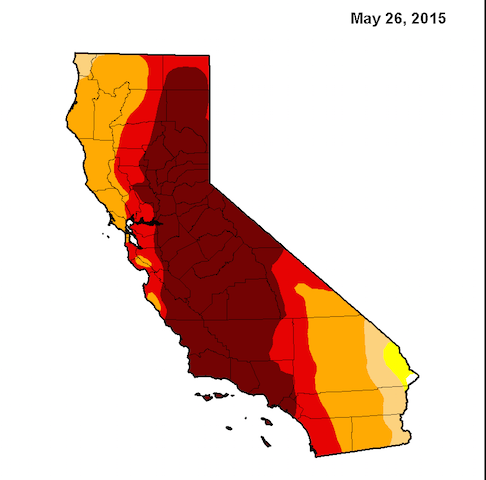Back when I was getting my public policy college degree in the 90’s, I really wanted to work for American Farmland Trust. At the time, I was living right in the epicenter of the effects of the Computer, Fiberoptic and Dot.com madness that was Northern Virginia. Where I lived in Fairfax County, there were big land grabs for developers. Once considered cornfield “country”, there were now huge McMansion housing developments. What was farmland was going away rapidly and all the growth stresses eventually brought me north to farm country— Carroll County.
The land preferred by developers, is the same land valued by most farmers. Once that land is taken and paved over or made ready for houses, it doesn’t come back into food production. So, in many areas that might have been suitable for growing a sustainable food supply, the option is no longer there. With development pressures, water shortages and weather extremes, it makes sense to diversify where we procure our foodstuffs.
California, as we know, is facing ongoing severe water shortages in the Central Valley where the majority the nation’s produce now grows. It began with the development of refrigerated rail cars and long distance transport led to us putting most all our eggs in one basket. Trucking foods long distance also contributes to the greenhouse gas problems.
- Central Valley-Food Basket
- Current and ongoing drought
Did you know that California contributes:
90% broccoli
99% artichokes
99% walnuts
97% kiwis
97% plums
95% celery
95% garlic
89% cauliflower
71% spinach
69% carrots
99% clingstone peaches
99% Figs
and leads the nation in growing onions, peppers, processing tomatoes, asparagus, lima beans, brussels sprouts, cabbages, kales, grapes, lettuces and herbs. That’s a huge burden to put on one area undergoing stresses of drought, climate change and development.
What can we do? For one thing, put parts of your property to use growing some of what you are going to eat. Improve your soils. Second, support your local farmers by purchasing at roadside stands, farmer’s markets and coops.
You’ve heard the term “locavore”? This is a person who eats locally produced foods, generally within 100 miles of point of purchase. Here is a map with the center of circumference in Westminster.

The problem with agriculture in Maryland is that we are small and urbanized. Our farms produce way more animal grain feedstuffs than fruits or vegetables for human consumption. Of the vegetables we do grow, 62% are the starchy type, like sweet corn or potatoes while 6% are green veggies, the rest being “Other”. Of fruit, 72% of what we grow in Maryland are melons. Berries are only 1% and the rest are things like apples and grapes. The only item produced that totally satisfies in-state demand is melons. For the rest, we have to look outside our state. It’s not that farmers aren’t growing other desired produce, it is just that the acres devoted to production are small relative to other things like grains.
Looking at our Locavore 100 mile map, we encompass all Maryland save Garrett County, a small part of West Virginia, portions of Pennsylvania, most of Delaware and part of Northern Virginia. Of these states, there are only a few top producing counties for vegetables and fruits.
In our Virginia radius Westmoreland County produces the most vegetables, followed by Loudoun. Shenandoah is the top fruit producer, likely to be apple orchards.
Our sector of West Virginia, Hampshire County, produces the most vegetables in that state, as well as the second largest fruit crop. Mineral County produces some veggies in the top ten rankings.
Our Pennsylvania areas best for vegetables by rank are Lancaster #1, Franklin, Northumberland and York Counties. Adams County is ranked #1 for fruit production followed by Franklin, Bedford, Lancaster and Berks.
Our circumference takes in most of Delaware, with Sussex County being the top producer of the three counties in that state.
Finally, in our own state of Maryland, top 5 ranking vegetable producers are Caroline, Dorchester, Wicomico, Baltimore and Queen Anne. Top fruit producers are Washington, Cecil, Montgomery, Carroll and Frederick.
Bon appetit!




